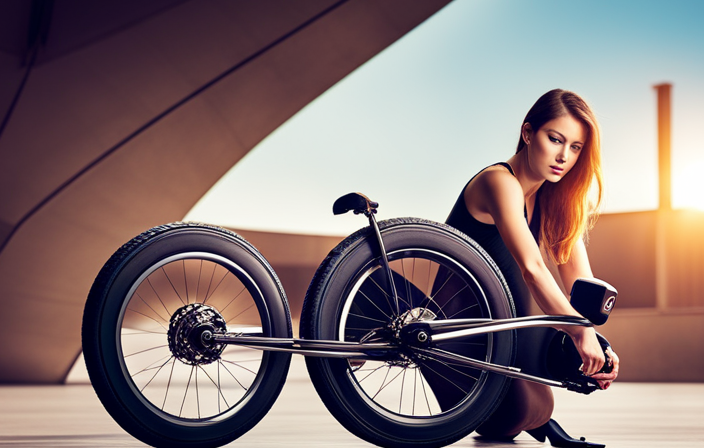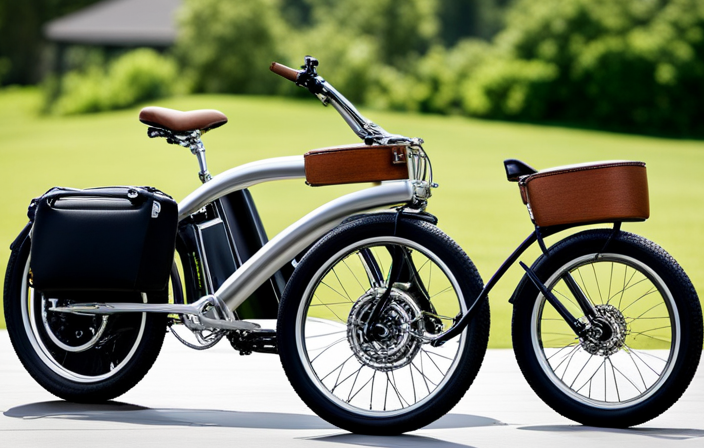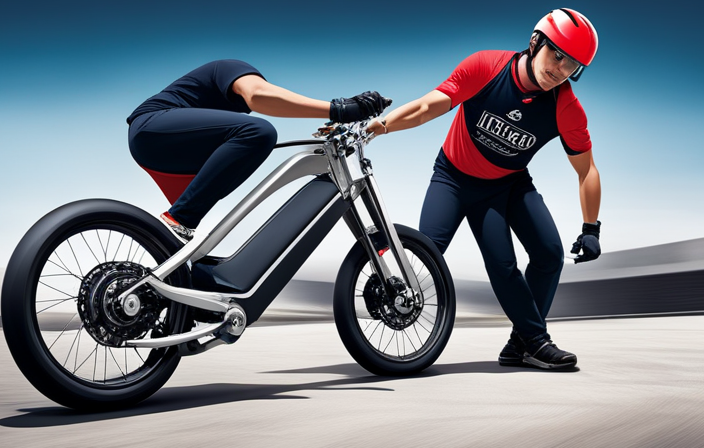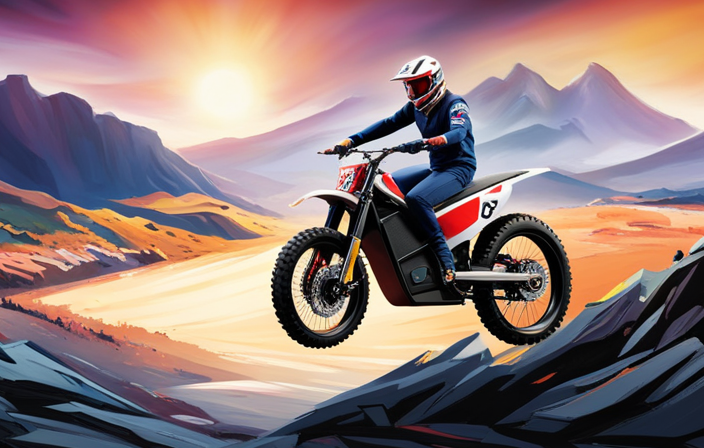Imagine cruising down the streets on your very own homemade electric bike, effortlessly gliding past traffic and feeling the wind in your hair.
In this second part of our guide on how to make an electric bike at home, we will delve into the technical aspects of building your own electric bike.
From selecting the right frame to wiring the electrical connections and fine-tuning its performance, we’ll cover everything you need to know to create a personalized, efficient, and exhilarating electric bike.
Get ready to take your DIY skills to the next level and transform your biking experience.
Key Takeaways
- Consider the frame material and choose one that suits your needs and budget (steel, aluminum, carbon fiber, titanium).
- Ensure the motor power matches the requirements of the electric bike, balancing power and battery drain.
- Choose the appropriate wire gauge for electrical connections and solder them properly for secure and reliable connections.
- Select the right pedal assist system for a smoother and more natural riding experience, enhancing the overall performance of the electric bike.
Choosing the Right Frame for Your Electric Bike
You’ll need to choose the right frame for your electric bike. The frame materials and frame geometry are crucial factors to consider.
When it comes to frame materials, you have several options to choose from, including steel, aluminum, carbon fiber, and titanium. Steel frames are durable but can be heavy, while aluminum frames are lightweight and affordable. Carbon fiber frames offer excellent strength and weight characteristics but can be quite expensive. Titanium frames are known for their strength and durability but come with a higher price tag.
Frame geometry is also important as it affects the bike’s stability, agility, and comfort. Consider factors such as the bike’s intended use and your body proportions when selecting the frame geometry.
Once you have chosen the right frame, you can move on to selecting the motor and battery components for your electric bike.
Selecting the Motor and Battery Components
When selecting the motor and battery components, it’s important to consider their compatibility with each other. Ensure that the motor power matches the requirements of your electric bike. A higher wattage motor will provide more power and acceleration, but it may also drain the battery faster. On the other hand, a lower wattage motor may not be able to handle steep inclines or heavy loads.
Additionally, consider the battery range, which refers to how far your electric bike can travel on a single charge. A larger capacity battery will provide a longer range, but it will also add weight to your bike. It’s crucial to find the right balance between power and range for your specific needs.
Once you have selected the motor and battery components, you can move on to wiring and electrical connections, ensuring a seamless integration of all the components.
Wiring and Electrical Connections
To ensure a smooth integration of all components, it’s important to properly wire and make electrical connections. When it comes to wire gauge selection, it’s crucial to choose the appropriate size to handle the current flow. A thicker wire gauge is needed for higher amperage applications, while a thinner gauge can be used for lower current flow.
It’s recommended to consult the manufacturer’s specifications or seek professional advice to determine the correct wire gauge for your electric bike. Additionally, soldering techniques play a vital role in creating secure and reliable connections. Properly soldering the wires ensures a strong bond and prevents loose connections that can cause electrical issues.
Once you have successfully wired and made electrical connections, you can move on to installing the pedal assist system, which will enhance the overall performance of your electric bike.
Installing the Pedal Assist System
Once the wiring and electrical connections are properly completed, it’s time to install the pedal assist system to enhance your electric bike’s performance. The pedal assist system, also known as PAS, is a fantastic addition to your electric bike as it provides numerous benefits. Firstly, it allows you to conserve battery power by utilizing your own pedaling energy, extending your bike’s range. Secondly, it provides a smoother and more natural riding experience by seamlessly integrating the motor power with your pedaling effort. There are various types of pedal assist systems available, including torque sensor-based systems, cadence sensor-based systems, and combined sensor systems. Each type offers unique advantages, so it’s important to choose one that aligns with your preferences and riding style. With the pedal assist system installed, you’re now ready to move on to building the brake and gear systems, ensuring a comprehensive and efficient electric bike setup.
Building the Brake and Gear Systems
After installing the pedal assist system, it’s important to focus on building the brake and gear systems for a well-rounded electric bike setup.
The brake system is crucial for ensuring safety and control while riding. Consider using hydraulic brakes, which provide excellent stopping power and modulation. They are more reliable and require less maintenance compared to mechanical brakes. Additionally, hydraulic brakes offer a consistent and powerful braking response, even in wet conditions.
Next, pay attention to the gear systems. Choosing the right gear ratios is essential for optimizing your electric bike’s performance. Aim for a wide range of gears that allows for efficient pedaling at different speeds and terrains. Consider factors such as the motor power and desired riding style when selecting the appropriate gear ratio range.
With the brake and gear systems in place, the next step is assembling the wheels and tires, which will be discussed in the subsequent section.
Assembling the Wheels and Tires
Now, let’s move on to putting together the wheels and tires for your electric bike setup.
The wheel assembly is a crucial step in ensuring a smooth and efficient ride. Start by attaching the hub motor to the rear wheel, making sure it is securely fastened.
Next, carefully insert the axle into the fork dropouts, making sure it is aligned properly. Tighten the nuts or quick-release skewers to secure the wheel in place.
When it comes to tire selection, consider the type of terrain you will be riding on. Opt for wider and knobby tires for off-road adventures, or go for thinner and smoother tires for city commuting. Remember to inflate the tires to the recommended pressure for optimal performance.
With the wheels and tires assembled, you can now move on to adding lights and reflectors for safety.
Adding Lights and Reflectors for Safety
To ensure your safety while riding, you should add lights and reflectors to your electric bike setup. Installing reflector brackets is an important step in this process. These brackets will securely hold the reflectors in place, allowing them to effectively reflect light and make you more visible to others on the road.
When choosing the right headlights for your electric bike, it is crucial to consider their brightness and beam pattern. Opt for headlights that provide a wide and focused beam, ensuring maximum visibility and safety during nighttime rides.
Additionally, it is recommended to use rear lights and reflectors to enhance your bike’s visibility from behind. By properly installing lights and reflectors, you can significantly reduce the risk of accidents and ride with confidence.
Now that you have added lights and reflectors, it’s time to move on to designing the handlebars and controls.
Designing the Handlebars and Controls
First, consider the comfort and ergonomics of the handlebars and controls for a better riding experience. Handlebar ergonomics play a crucial role in preventing fatigue and maintaining control while riding your electric bike. Ensure that the handlebars are at a comfortable height and width, allowing for a natural grip and easy maneuverability.
Additionally, pay attention to control placement. Position the throttle, brakes, and other controls in a way that allows for easy access and operation without straining your hands or wrists. This will enhance your overall riding experience and reduce the risk of accidents.
Moving on to the next section about creating a comfortable seat and suspension, it is important to optimize your bike’s ride quality for maximum comfort and enjoyment.
Creating a Comfortable Seat and Suspension
Consider optimizing your seat and suspension to ensure maximum comfort while riding.
Creating an ergonomic design for your seat is crucial to prevent discomfort during long rides. Explore different suspension options to absorb shocks and vibrations, providing a smoother and more enjoyable experience.
Here are five key factors to consider when designing your seat and suspension:
-
Seat cushioning: Invest in a high-quality foam or gel cushion to provide adequate support and reduce pressure points.
-
Adjustable seat height: Customize the seat height to fit your body size and riding style.
-
Suspension type: Choose between front suspension forks, rear suspension systems, or a combination of both to absorb bumps and improve stability.
-
Seat angle: Adjust the seat angle to achieve a natural and comfortable riding position.
-
Suspension tuning: Fine-tune the suspension settings to match your weight and riding preferences.
By optimizing your seat and suspension, you can enhance your riding experience and minimize fatigue.
Now, let’s move on to customizing the body and paintwork.
Customizing the Body and Paintwork
To personalize your ride, you can customize the body and paintwork to reflect your unique style and personality. Customizing the color of your electric bike is a great way to make it stand out from the crowd. You can choose a bold and vibrant color that suits your taste or opt for a more subtle and sophisticated shade.
Additionally, you can add decals to further enhance the visual appeal of your bike. These decals can be customized with logos, patterns, or any design of your choice. When applying the decals, ensure that the surface is clean and smooth to achieve a professional finish.
Once you have customized the body and paintwork, you can move on to testing and troubleshooting the electric bike, ensuring that everything is functioning properly.
Testing and Troubleshooting the Electric Bike
Now that you have customized the body and paintwork of your electric bike, it’s time to move on to the next crucial step: testing and troubleshooting. This step is essential to ensure that your bike is safe, efficient, and performs optimally. By testing your electric bike, you can identify any potential issues and address them before hitting the road. There are various testing methods you can employ, such as checking the battery voltage and capacity, testing the motor and controller, and assessing the overall functionality of the bike. Additionally, troubleshooting techniques can help you pinpoint and resolve any problems that may arise during the testing process. By thoroughly testing and troubleshooting your electric bike, you can fine-tune its performance and speed, ensuring a smooth and enjoyable ride.
Fine-tuning the Performance and Speed
Once you have completed the testing and troubleshooting process, you can easily fine-tune the performance and speed of your customized electric bike.
To improve acceleration, consider upgrading the motor controller to a higher voltage or amperage rating. This will allow for a quicker response when you twist the throttle.
Additionally, you can adjust the gear ratio by either changing the front or rear sprocket size. Increasing the sprocket size will provide more torque, while decreasing it will increase top speed.
Another way to enhance the performance is by increasing the battery range. You can achieve this by adding extra battery packs in parallel, effectively doubling the capacity. This will allow you to ride for longer distances without needing to recharge.
To maintain and service your electric bike, regular cleaning and lubrication of the chain, checking tire pressure, and inspecting the electrical connections are essential.
Maintaining and Servicing Your Electric Bike
Regular maintenance and servicing of your e-bike is crucial to ensure its optimal performance and longevity. To keep your electric bike running smoothly, here are some important maintenance tasks:
-
Regularly clean the bike: Use a mild detergent and water to clean the frame, wheels, and components. Avoid using high-pressure water as it may damage sensitive parts.
-
Check tire pressure: Maintain the recommended tire pressure to ensure a smooth and efficient ride. Inspect the tires for any signs of wear and replace them if necessary.
-
Lubricate the chain: Apply a suitable lubricant to the chain to reduce friction and prevent rust. Wipe off any excess oil to avoid attracting dirt.
-
Troubleshooting tips: Familiarize yourself with common issues such as battery problems or motor malfunctions. Refer to the manufacturer’s manual or seek professional help if needed.
By following these electric bike maintenance practices, you can keep your e-bike in top condition.
In the next section, we will explore how to upgrade and expand your electric bike features.
Upgrading and Expanding Your Electric Bike Features
To enhance your e-bike experience, you can easily upgrade and expand its features.
One way to do this is by improving the charging infrastructure of your electric bike. Consider investing in a high-quality charger that can charge your battery more efficiently and quickly. This will allow you to spend less time waiting for your bike to charge and more time enjoying the ride.
Additionally, you can explore performance upgrades for your e-bike. This may include upgrading the motor or battery to increase power and speed. You can also install a suspension system to improve comfort and handling.
Remember, safety is paramount when upgrading your e-bike, so be sure to follow all necessary safety precautions and legal considerations. This will ensure that you can enjoy your upgraded e-bike to the fullest extent.
Moving on to safety precautions and legal considerations…
Safety Precautions and Legal Considerations
Before upgrading and expanding your e-bike features, it is important to consider safety precautions and legal considerations. To ensure a safe and legal electric bike, here are four key factors to keep in mind:
-
Safety regulations: Familiarize yourself with the safety regulations specific to electric bikes in your area. This includes understanding the maximum speed limits, age restrictions, and helmet requirements.
-
Legal requirements: Make sure your electric bike meets the legal requirements set by your local authorities. This may involve registering your e-bike, obtaining a license or permit, and adhering to specific manufacturing standards.
-
Braking system: Enhance your e-bike’s braking system to ensure efficient and reliable stopping power. This may involve upgrading to hydraulic disc brakes or installing regenerative braking technology.
-
Lighting and reflectors: Install proper lighting and reflectors to enhance your visibility on the road, especially during low-light conditions. This includes front and rear lights, reflectors on the wheels, and reflective strips on the frame.
By considering these safety precautions and legal requirements, you can enjoy an upgraded and expanded electric bike while ensuring the safety of yourself and others.
Frequently Asked Questions
How much does it cost to build an electric bike at home?
Building a DIY electric bike at home can be a cost-effective alternative to buying a pre-made one. The cost of building an electric bike at home can vary depending on several factors, such as the quality of components, battery capacity, and additional features desired.
On average, the cost can range from $500 to $2000. However, it’s important to research and compare prices for individual components to ensure you stay within your budget while building your own electric bike.
Are there any specific tools or equipment needed for building an electric bike?
To build an electric bike, you’ll need a few specific tools and equipment. Nothing too crazy, but you can’t just use your regular toolbox.
You’ll need an electric bike conversion kit, which typically includes a motor, battery, and controller. Other necessary tools include a torque wrench, a spoke wrench, a chain breaker, and a multimeter for electrical testing.
Without these tools, your electric bike dreams will remain just that – dreams. So gear up and get ready to electrify your ride!
Can I use any type of frame for my electric bike or are there specific requirements?
When considering alternative frame options for your electric bike, it’s important to keep in mind that there are specific requirements.
The frame should be sturdy and able to handle the added weight and torque of the electric motor. A frame made of lightweight materials such as aluminum or carbon fiber can provide the benefit of reducing overall weight and increasing maneuverability.
Additionally, a frame with sufficient space for the battery and other components is essential for a successful electric bike build.
What are the legal considerations and regulations for riding an electric bike?
To ride an electric bike legally, you must consider licensing requirements and safety regulations.
Just as a driver’s license is necessary to operate a car, some jurisdictions require a special license for electric bikes.
In terms of safety regulations, speed limits and helmet laws may apply. For instance, in California, electric bikes are classified based on their top speed, with different regulations for each class.
It is crucial to familiarize yourself with the specific laws and regulations in your area to ensure a safe and legal ride.
How often should I service and maintain my electric bike?
To ensure optimal performance, it is recommended to service and maintain your electric bike regularly. Electric bike maintenance frequency can vary depending on usage and the specific model, but a general guideline is to have a comprehensive service every 6-12 months.
This includes checking and adjusting brakes, gears, and tire pressure, as well as inspecting the battery, motor, and electrical components. Common electric bike issues include worn-out brake pads, loose connections, and battery degradation, so regular maintenance can help prevent these problems.
Conclusion
Congratulations! You’ve reached the end of your journey into the world of DIY electric bikes. With your newfound knowledge, you can confidently choose the perfect frame, select the ideal motor and battery components, and expertly wire and connect all the electrical elements.
By installing the pedal assist system, building the brake and gear systems, and fine-tuning the performance, you’ll create a ride that’s like poetry in motion.
Remember to maintain and service your electric bike regularly, while exploring upgrades and expanding its features. Just be sure to prioritize safety and adhere to all legal considerations.
Happy riding!









